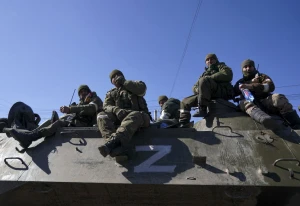
Will Russia move troops from Syria to Ukraine? Serhiy Zgurets' column
Could Russia transfer the troops currently concentrated in Syria to the war in Ukraine following the fall of Bashar al-Assad's regime? What are the unique aspects of combat operations for Ukraine's “Typhoon” special-purpose UAV unit?
Situation in Syria
So, let’s start with the events in Syria, where the balance of power and interests is rapidly shifting. Bashar al-Assad's regime has been destroyed. This was expected back at the beginning of the war in Syria in 2011, but it didn't happen then because in 2015, Assad's regime was saved by the alliance of Iran and Russia, which provided military support.
Currently, Russia, like Assad, who fled to Russia, faces the prospect of a total withdrawal from Syria. This represents a loss of Russian influence in the Middle East and Africa. In Syria, as we know, Russia had two bases. One was the Khmeimim base in the Latakia province, where Russian aviation, with several dozen Su-24, 25, 30, and 34 aircraft, was stationed. These aircraft were used by Russia to bomb Syrians with bombs and missiles, and this experience was later transferred to Ukraine.
The second base is an important naval base for Russia in the Mediterranean, the Tartus naval base, which was leased to Russia for 49 years. On December 8, Ukraine's Main Intelligence Directorate reported that the frigate "Admiral Grigorovich" and the cargo ship "Engineer Trubin," which were stationed there, left Tartus and headed into the Mediterranean Sea. This marks a certain evacuation of Russian troops from this area.
Intelligence sources report that in the Mediterranean Sea, Russian ships are stationed, which typically transport stolen Ukrainian grain to Syria, which has served as a hub for reselling this stolen grain. These threats remain, and it's unclear where to move next. Additionally, the Russians are transferring the remnants of their weapons and military equipment from Syria aboard ships from the Khmeimim base, as reported by the Main Intelligence Directorate.
Meanwhile, in Moscow, there are confused voices, including Peskov, who says that it is still too early to discuss the preservation of Russia's military presence in Syria. This will supposedly be a subject of discussion with the new government in Syria. Russia is currently negotiating with Turkey about the security of its troops in Syria and the corridors. The withdrawal of troops and the attempt to negotiate with the new international coalition about maintaining Russia's presence in Syria will, in my opinion, require significant concessions from the Russian Federation in dialogue with Turkey, Israel, and Western countries on other issues, including, in particular, the conditions for ending Russia's war against Ukraine. This conclusion can also be drawn from this situation.
In the event of a withdrawal of Russian troops from Syria, if this begins to unfold, the Russians would, in one way or another, have the opportunity to redeploy certain organized groups and their troops from Syria to the front line with Ukraine. Such assumptions have been made in the conclusions of some experts. Overall, before the fall of Assad's regime, there were about 7,500 Russian troops in Syria. These included military personnel, Wagner fighters, the majority of whom were rotated to Syria after Prigozhin's rebellion to keep them farther from Moscow.
Will Moscow now redeploy these troops to the Ukrainian border? I believe it's premature to draw such conclusions, as this won't happen quickly. Moreover, the Wagner fighters themselves understand what fate awaits them here. On the other hand, when we talk about the other component, the aircraft stored at the Russian aviation base, they do indeed pose a certain threat. However, I hope these planes won’t be redeployed - won’t reach their destinations, won’t fly, won’t arrive. I hope this will be an important part of the position of European countries and Turkey, which will likely now be involved in negotiations with the Russian Federation regarding the fate of Russian military assets and personnel in Syria.
Special features of Typhoon unmanned special-purpose systems warfare
Now, let's move on to Russian-Ukrainian front, where Russia is trying to use its advantage in manpower and equipment. We know that the Russian military is mainly trying to create conditions for advancing in the Pokrovsk direction, but there are other complex areas that can be listed. These include the Kurakhove direction, the situation around Velyka Novosilka, and the fighting near Kupyansk. Ukrainian units and brigades are operating there.
Mykhailo Kmytiuk, commander of a separate unit of special-purpose unmanned systems Typhoon of the National Guard of Ukraine, spoke about the specifics of the fight in these areas. He noted that the units are currently performing tasks in some of the most difficult areas - Pokrovsk and Kupyansk: “Not only are we in these areas, but these particular areas are probably the most difficult for our units today.”
He also spoke about the differences between these two areas and how they affect the peculiarities of the Russian actions.
"The impact is quite simple. Alternately, both sides are carrying out assault actions, with constant dynamics and movement of Russian troops towards us. The enemy tires, then regroups, and continues advancing. This alternates on both fronts. In fact, for the operators, it is a very intensive and complex job. The main stages of the operators' work can be divided into phases and tasks. These include mission planning, equipment setup, tactical training, and most importantly, mission execution. Launching, drone management, real-time monitoring, and, of course, fire correction. Typically, one group of operators can work continuously for 12 to 18 hours a day," said the squad commander.
Mykhailo Kmytiuk also spoke about the quantitative demand for FPV drones, noting that it seems that with each passing month, the need for these drones grows more and more.
"The first factor that impacts us today is the change in the enemy's tactics. The Russians move with one or two men when advancing, so the number of FPV drones is equal to the number of occupiers advancing towards us. Then there are electronic warfare systems, which have become more powerful. So, we also lose drones when Russian EW is used, which again increases the consumption of FPV drones," he noted.
I heard from various teams that they are now purchasing most of the drones on their own or receiving them from volunteer organizations, while the state supplies a smaller part.
“We have a combined supply system. Basically, the state supplies it to the units, but sometimes, because of such a long process of codification and registration, we need, of course, the help of volunteers. Because we need to meet the operational needs. The guys need to work today. Accordingly, we are also turning to foundations for help to cover this need,” said Mykhailo Kmytiuk.
According to him, one of the most memorable Russian targets destroyed was an expensive Russian electronic warfare system: “We took an experimental approach. We trained people from scratch. Since we were a newly formed unit, we recruited people who had absolutely no skills in flying an FPV drone. In six months, our fighters destroyed, as an example, a $200 million Borysoglebsk-2 (Russian electronic warfare system - ed.). That is, the training lasted six months and, in principle, the guys proved to be quite effective.”
The detachment commander also spoke about the so-called trends in drone modernization: drones with fiber optics, drones with thermal compound.
“Fiber optic drones: both the Ukrainian and Russian sides are actively experimenting with the use of these drones. Their main advantage, of course, is their insensitivity to electronic warfare, because they are not controlled via radio. So far, this is not a widespread phenomenon, but it allows us to avoid interference from electronic warfare. As for thermal mixtures, I can say that this is also not a mass phenomenon, it is one of the tactics used by individual units, and possibly brigades. As a tactic, it has the right to exist, but as such, it is not a mass phenomenon,” he said.
The Typhoon unit, like the Russian troops, is also working on homing drones at the end of the line: “Of course, as soon as they can select targets and launch attacks, the operator will confirm the target, of course, this increases the speed and efficiency of hitting the target. So we are working on solving this problem.”
When you talk to a unit that deals with drones, the question arises that the drones supplied to the unit still need to be modified, customized, that is, brought to a certain level of new requirements. And this is what the military itself is doing.
“There is a whole aeronautical engineering team that works to ensure that the pilot doesn't have to think about what to do with the drone. They do everything to flash the drone so that it is ready for use. In principle, we can say that this issue is almost closed today,” said Mykhailo Kmytiuk.
According to him, warfare in 2024 is impossible without attack drones: “Therefore, it is vital along the entire front line. This is a cheap, effective solution that will allow us not only to receive, but also to effectively defeat and destroy the enemy.”
Fighting Shaheds and Russian helicopters
And next, we will talk about examples of the fight against the Russian Shahed drones. We know that they are being fought with the help of mobile units and air defense. Since the summer, Ukraine's army aviation has been involved in this with the use of helicopters.
Just recently, a video was released showing two of the Ukrainian army's Mi-8 helicopters hunting for a Russian Shahed. This video shows that this process is not easy. The Shahed is in the air for a long time, and one Mi-8 helicopter accompanies it, and at a certain stage the second Mi-8 is already involved, which destroys the drone with the help of a machine gun mounted on the helicopter.
Another video was released by the Security Service of Ukraine, which shows the potential for expanding the capabilities of Ukraine's Magura and other versions of maritime drones, which have already begun to be equipped not only with FPV drones that can also attack Russian targets approaching Ukrainian maritime drones. They have also installed machine guns on these drones, which can also track the approach of Russian helicopters and launch attacks on Russian helicopters with these weapons.
A video from the Security Service of Ukraine shows that Russian helicopters attempting to approach Ukrainian maritime drones came under heavy fire from this machine gun. Several Russian crew members were wounded, and the helicopters sustained significant damage, requiring extensive repairs.
And also with the help of these maritime drones, a Russian ship was attacked, which was trying to transport equipment to strengthen the security of the Kerch Bridge. This vessel was also attacked by Ukrainian drones, which means that Magura maritime platforms have become multifunctional components of warfare, where they can be not only kamikaze drones, but can also attack Russian air targets, which is extremely important in terms of expanding the capabilities of our unmanned systems.
In general, we can say that the technology and good skills of Ukrainian operators are, in fact, an asymmetric approach to the quantitative advantage that the Russians have in terms of manpower and equipment.
- News











































